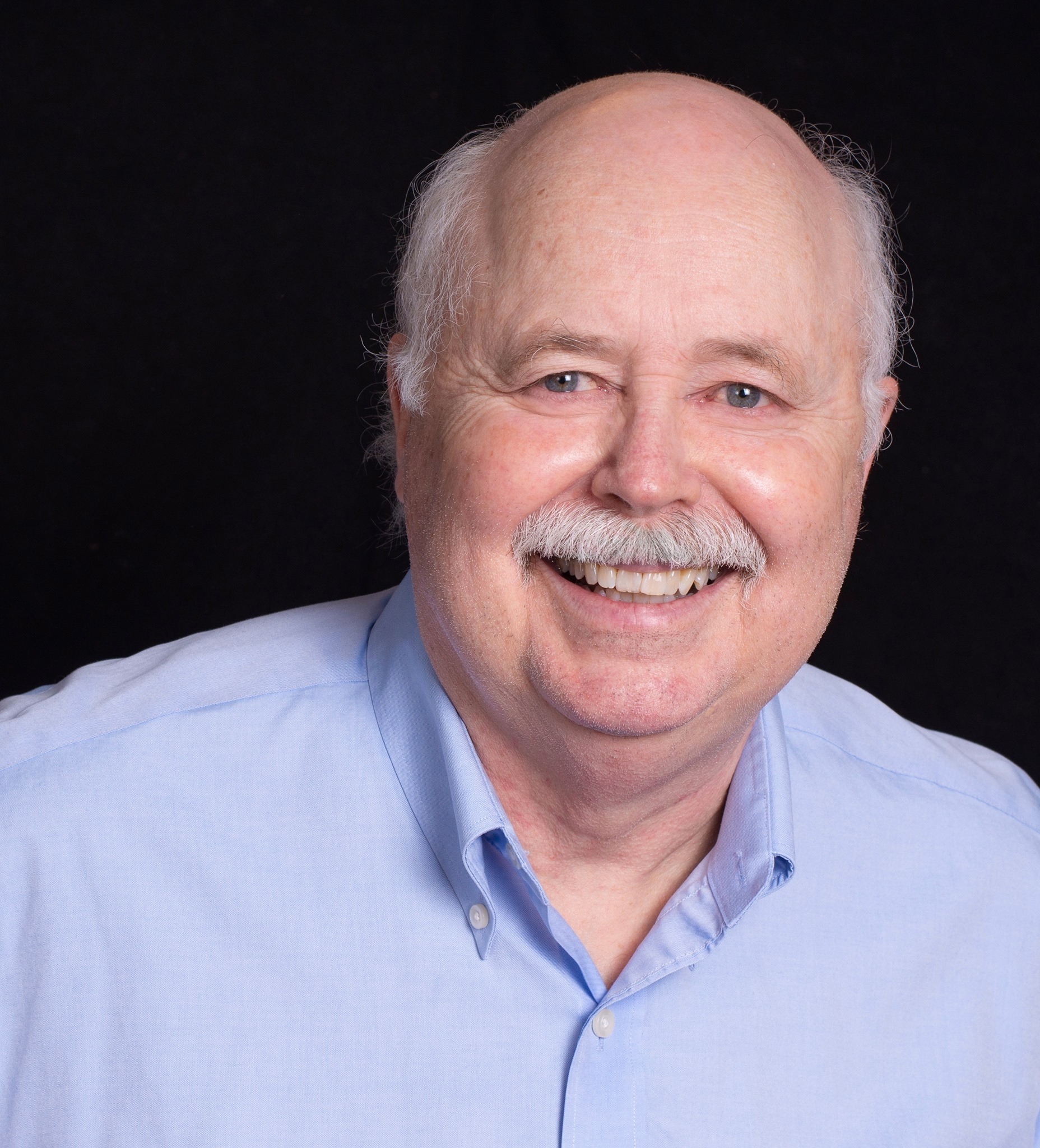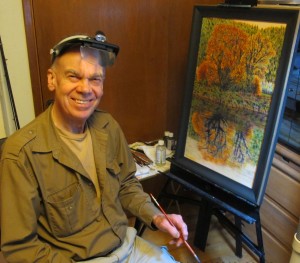
Were you to talk to Stan Gabelein about art, he ultimately will tell you of when he was a little kid in first grade, and how he would spend all of his time drawing pictures. His constant drawing became such a problem for his teacher, he will tell you, that she actually held him back a grade because of it; a fact that may not speak well for his teacher, but does say a great deal about Stan, who by his own assessment has always been an artist. Now in his seventies, today Stan laughs while telling that story; but one can sense, even after all this time, a bit of the frustration he felt as a young kid trying to find a way for his passion and talent to manifest. Obtuse teachers, I am certain, have ruined more than one budding young artist; just as wise ones have helped others. Fortunately, both for Stan and for those who enjoy his art, he wasn’t about to be stopped.
A lifelong Washingtonian, born and raised; through his youth Stan was taught the ways of the outdoors. His father was an avid hunter and fisherman who not only passed on his skills to his son, but also his abiding respect for nature. Consequently Stan has hunted deer, elk and moose all over the Northwest, Montana, Wyoming and Alaska, and fished the waters of that same country for trout, salmon, bass and, when in Alaska, the famous Northern Pike; a 26 lb trophy of which can be seen hanging on the wall in his studio. With his abundance of outdoor experiences indelibly etched in his mind, and there mixing with his yearning to draw and paint, it was only natural for Stan to seek the outlet of becoming a skilled artist. His first major effort to do so took place as a young man when he attended Western Washington University in Bellingham, majoring in art. Of his time at Western, Stan says, “Truth be told, I didn’t get much out of it; and though I was always interested in art, I didn’t do much with my education for quite some time. I had memorized a bunch of art history and knew everyone’s commentary and opinions, but what I wanted to know was simply how to REALLY paint.”
So with his pent up artistic purpose still churning inside, Stan went about the business of making a living for himself and his family. He started a top soil business on his native Whidbey Island and ran it successfully for a number of years while continuing to hunt and fish at every opportunity…and the time went by. And then, virtually right under his nose, he met the person who was to hand him the key to unlocking the barriers to his real purpose.
As islands go, Whidbey Island is decent size, but it’s not that big. Located in northern Puget Sound, not far from Seattle, when you depart the ferry that takes you there you instantly sense the change from the hectic pace of the city to the laid back vibe of the country. There are a few small towns and a Naval Air Station on the island, but they do nothing to change the rural feel induced by the many broad meadows you will see, interspersed with forested stretches of Douglas Fir, Western Red Cedar and Western Hemlock. Deer abound on the island and can be frequently seen browsing in the meadows. It is an idyllic place for sure, and one in which, sooner or later, every resident will encounter every other resident. The irony is, considering the artistic purpose they both share, that it took so long for Stan to meet Libby Berry.
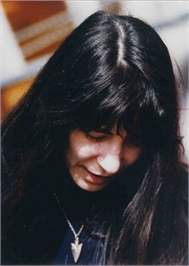
Now, I am not here to tell you the story of Libby Berry—I am here to tell you Stan’s—but the truth is that Stan himself states that his career as an artist never really got going until he met Libby. His story, therefore, is so intertwined with Libby that it is impossible to tell without you knowing something of her; so here is a thumbnail synopsis: Libby Berry has been painting since she was 12 years old. Also now in her seventies, she has been living on Whidbey Island for the last 35 years; where she has her studio and where she also runs an art school called the “New Renaissance Academy.” As the title of her school indicates, Libby has dedicated her life to the rediscovery and teaching of the lost techniques of the master Renaissance painters, epitomized by Leonardo da Vinci , but embracing many other great artists as well.
Once she had established her goal to be a great artist, her initial mission was to discover how it was that the great masters were able to imbue their paintings with such emotion and life quality. It was a search that took her half way around the world and into the depths of art museums, galleries, books and authorities. At long last she made a breakthrough with the discovery that the key to the masters’ art was the use of colors in such a way that they mirrored the natural laws of light. According to Libby, “The qualities of life are created by a common technical use of color. It looks like a symphony orchestra sounds.” By implementing this breakthrough in her own painting Libby’s art took a sudden and shocking quantum leap forward, and she became one of the world’s premier wild life artists in very short order indeed; her paintings selling for as much as $25,000. Today her paintings are in private art collections the world over and she has trained over 200 students in her master’s techniques. Little did Stan Gabelein know, the person who would assist him the most in unlocking his talent and desire to paint, was practically his Whidbey Island next door neighbor, and had been for years.
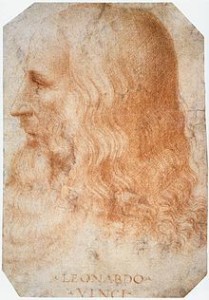
Stan finally met Libby in the early 1990’s, and states that after talking to her and learning of her breakthroughs, “I realized that I really wanted to learn how to paint the way the masters did… it was inside me and it had to get out. I just had to have that tech…” Needless to say, in Stan Gabelein Libby had found an eager pupil; and that pent up drive to express himself through art that had been riding dormant since first grade, was about to be unleashed. He signed up for her course, jumping in with both feet; and from that point on he was revitalized as an artist. Stan describes the effect that Libby’s training had on him as follows: “That was the most incredible learning experience…and I was so excited that all I wanted to do was paint. So I did. I painted a lot. It was great, and I enjoyed the hell out of it!”
Having learned how to compose a picture as part of Libby’s training, Stan initially painted anything that he liked, or that struck his fancy. Not surprising for an artist with an outdoors bent, many of these early paintings reflect Stan’s love of wildlife and the natural environment. His works include many pictures of deer and elk, as well as a mountain goat, a cougar and even a chipmunk. As he developed his own personal technique and style his subject matter broadened to include paintings of people in natural settings, usually while hunting or fishing; and often with a humorous angle. Of this last, one picture of Stan’s comes to mind of a hunter who had just dropped his drawers to take care of nature’s business when a bull elk comes crashing through the bush right in front of him. The painting captures the hunter with his pants halfway down as he reaches for his rifle; and you get the distinct impression that this is a picture drawn from a real life dilemma.
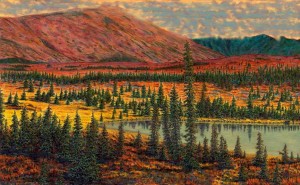
Where Stan really comes into his own for me, however, is in his paintings of natural scenery—the mountains, rivers, lakes and meadows he has seen in his travels. One of these is a picture entitled “The Denali”, which is a wild area in the interior of Alaska north of Anchorage. The painting captures the landscape clothed in fall colors which literally leap off the canvas at you. Another painting, entitled “Coulee Country”, depicts an enchanting scene on Banks Lake in Eastern Washington, one of Stan’s favorite fishing destinations; and yet another captures an eagle in flight against a fog cloaked hillside. There are many more, and while they all display different scenes and vistas, the common denominator of each is the impact they have on the eye; the picture just seems to reach out and grab you. I have seen the same quality in Libby Berry’s paintings, as well as in those of some of her other students I have met. Clearly there is something to Libby’s discovery about the use of color in alignment with the natural laws of light, and just as clearly Stan has duplicated it.
In an interview I had with Stan recently I asked him about this life quality he imbues into his paintings. Just how does he do it? As you would expect, his answer reflects his training:
“It’s just in the color that I use,” he said. “I use contrasting colors a lot. And I try to play on that, and it really works. I use what is called ‘crimson flash’. I use that a lot—‘crimson flash’—the masters used that. Its crimson paint and you paint just a little bit, right on the edge between light and shadow, and it pops it…gives the illusion of depth. And that is the way I paint…I’m an illusionist. I play with, like I say, the contrasting colors; crimson, and the whole palette of color; I give the illusion of 3 dimensions…it’s a lot of fun.”
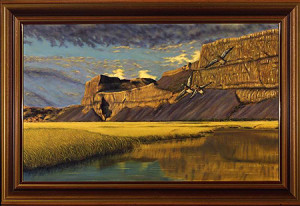
I noticed that as Stan uttered the word “illusionist” he emphasized it; and the more I thought about it, the more I realized how right he was. All artists are, in their essence, illusionists. In the case of a painter, they take that flat, two dimensional piece of canvas and by the time they are done, if they are good, that flat piece of canvas has become a portal to another time, another place, another world. In that one word, I realized, Stan had captured the salient quality of who he really is as an artist, and what he is really doing.
As to why he paints, Stan is no less clear:
“I want to create an effect on people,” he says. “I want people to see my stuff and just be able to look at it again and again, and see something different every time. A lot of my paintings are like that.”
In order to create that effect, as Stan paints a picture he actually goes through, for want of a better description, an emotional cycle. He has figured out for himself that he must go all the way through this cycle on each painting, for it to be complete. The cycle, and each painting, starts in what Stan calls the emotion or state of “aesthetics”. In describing this he says, “Wow! There’s nothing like it! I mean I’m way up there (emotionally). See, I create a painting, I start that painting, and I am in ‘aesthetics’ and above when I start that painting.”
Then, as he goes through the process of painting the picture, he says, “I’m all over the emotional scale (anger, happy, bored etc). But, when I finish that painting I have to again be at ‘aesthetics’ and above.”
Thus, in his own emotional state Stan has realized a valuable tool, in addition to what he sees on the canvas before him, to know when a painting is complete, and will create the effect on others that he intends.
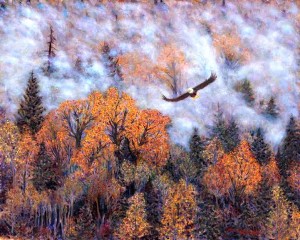
On hearing Stan describe how he uses his emotions to assist his painting I was struck by the difference in how he viewed his emotions compared to how the vast majority of people I have met viewed theirs. Most people are the effect of their emotions, many even taking drugs to solve their unwanted emotions, which clearly does not work. Yet here was a man who not only could easily experience his emotions, he actually wanted to. He had achieved the wisdom of knowing that in his emotions there was nothing to fear, and that one actually causes their own emotions, and not the other way around. This led to a fascinating discussion I had with Stan, about how else this increased wisdom and awareness assisted him as an artist. His initial answer to that question surprised me:
“I can see better,” he said.
I looked at him quizzically. “See better how?” I asked. “Do you actually see the picture better physically? Or is it in your mind’s eye?”
Stan laughed. “Both,” he said. “I can see better in my mind’s eye, we’ll put it that way…much better than I used to.”
He went on to describe how, as he developed as a painter and became more aware, his visualization of a picture improved. In some instances this prompted him to go back to some of his earlier paintings and “correct” them, as he now “saw” them better. He gave the example of clouds in a painting that he had painted earlier, that to him now looked like concrete; so he took that painting and “fixed” it, making them look like the clouds he now saw clearly.

As Stan was explaining this to me my attention was attracted to a particularly beautiful painting of two deer in a meadow that was sitting in his studio among a number of other paintings. I had been under the impression that most painters painted from an actual photo of their subject, and this painting of the deer made me wonder about that, as ordinarily you can’t get a photo of two deer in the wild like that so close. So I asked Stan about how he got the original photo for that picture. Once again his answer surprised me. That picture of the deer, he said, was painted from an imaginary image in his mind and not a physical universe picture. He went on to describe a current series of pictures he is painting that all have “outer space” motifs, and they all are taken directly from his imagination, or “my universe” as Stan calls it:
“Now I’m painting outer space…and the thing I really love about painting outer space is that it’s so free flowing, and anything goes. I can empty the palette… and I can do the same thing I did with regular landscapes…and all those other paintings…there are no restrictions really… all my outer space paintings are from ‘my universe’…It’s a lot of fun…but I have painted landscapes that way too… from ‘my universe’…just like that deer painting there…I don’t always need a picture.”
To me, to be able to paint a picture with the detail visible in that painting of the two deer in the meadow, and do it from an image in your mind—now that is impressive.
As for his future projects, Stan has big things in mind—literally; and when he speaks of them his eyes illuminate, as if backlit by some passion stoked inferno:
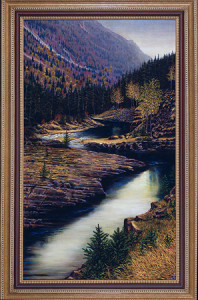
“You know I’ve always wanted to paint a huge canvas,” he says, “like the Hudson River School painters…have you ever read about them? Albert Bierstadt and those guys? My God, they painted huge canvases; they had these huge studios in New York. Their canvases could be 12 feet long by 8 or 10 feet high…And there was a guy, I think his name was Thomas …and at the Seattle Art Museum several years ago they had a lot of his paintings on display. And there was a huge landscape, and there was a river in it, and mountains you know, oh my God! It was so incredible that I swear I could’ve walked right into it! That’s the impression it gave me. Those guys were illusionists. They give the illusion of 3 dimensions. Those guys were great. And they used the same techniques as the late renaissance masters.”
There’s that word again—“illusionist.”
From his frequency of using it, and the way he emphasizes it; one comes to understand that the concept of that word is central to whatever effect Stan is trying to create with his art.
Indeed, from Da Vinci to Bierstadt, the same can be said of the great masters. The techniques they developed and used, as re-discovered and passed on to Stan, are simply the “how to” of creating that illusion.
Stan Gabelein has figured all that out, and when talking to him about his art, from the joy in his voice and the twinkle in his eye, one can see that he cherishes the legacy.
And I think that is something the great masters would be proud to know.
Copyright © 2016
By Mark Arnold
All Rights Reserved
(For more information about Stan Gabelein and his art visit his website at )
For more information on Libby Berry, her paintings and the “New Renaissance Academy” please go to her website at
Leonardo da Vinci (1452-1519) was a late Renaissance painter, widely considered the greatest of all time, whose works include “Mona Lisa” and “The Last Supper.” As great as he was da Vinci was much more than an artist, he was also an inventor, a writer, an architect, a scientist, a mathematician, a sculptor, an engineer and, incredibly, a paleontologist, among other things.
The “Emotional Tone Scale” was first described by L. Ron Hubbard in his book “Dianetics: The Modern Science of Mental Health” in 1950. A year later he wrote a book called “Science of Survival” which further described the scale and how it can be used to predict human behavior. Later observations by Hubbard resulted in the understanding of the higher levels (or wavelengths) of the scale, one of which is “aesthetics”. When Stan states that he is in “aesthetics” this is what he is referring to.
The Hudson River School was a mid 19th century American art movement characterized by painters who mainly created paintings of landscape scenes of the Hudson River valley and surrounding areas of New York. Eventually the school and its artists expanded to include other locales and landscapes, including the American West. Their paintings were noted for their size and for the reverence with which the artists rendered the natural landscapes they painted.
Albert Bierstadt (1830 – 1902) was a German-born American artist best known for his lavish, sweeping landscapes of the American West. To paint the scenes, Bierstadt undertook several journeys into the west. Though not the first artist to record these sites, Bierstadt was the foremost painter of these scenes for the remainder of the 19th century.

Likely the “Thomas” Stan is referring to here was Thomas Moran (1837-1926), a landscape painter of the HudsonRiver school who specialized in paintings of the American West. In 2011 there was an exhibition of a number of Hudson River school artists’ paintings at the Seattle Art Museum, including several by Thomas Moran.

